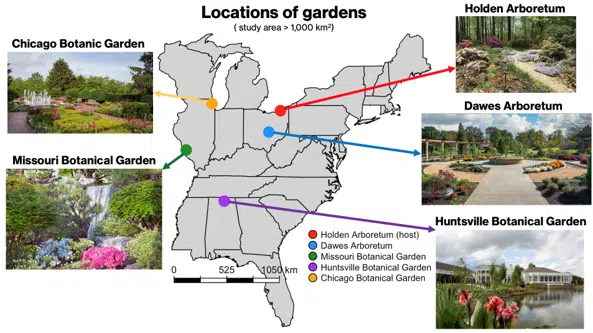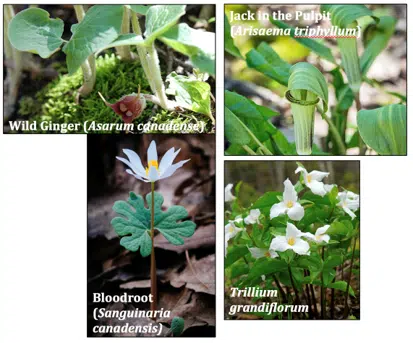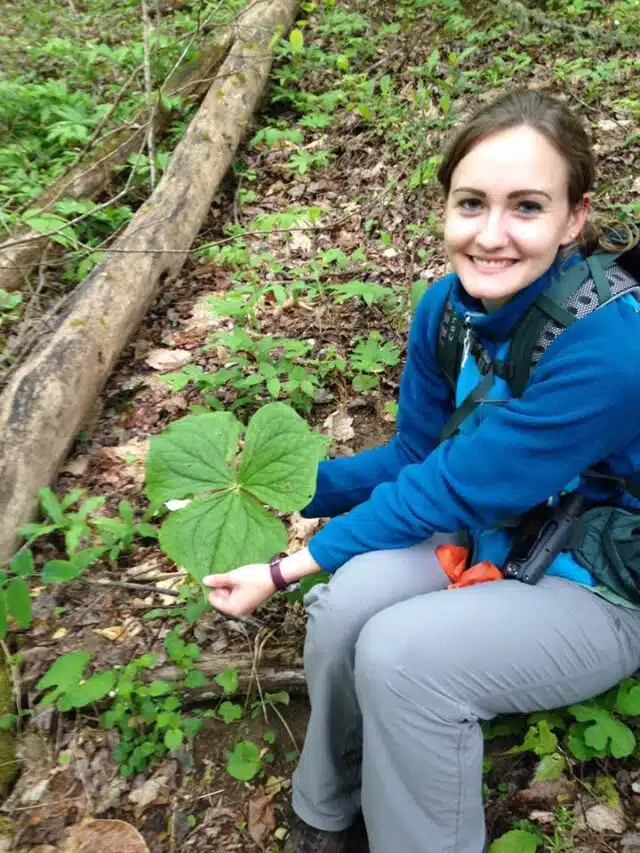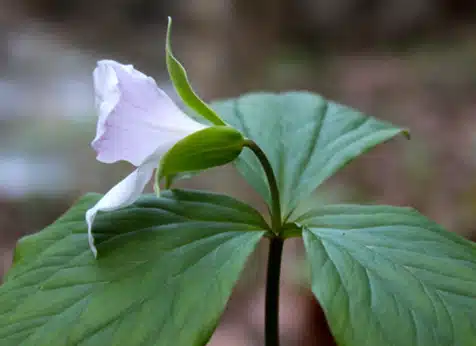
In addition to being beautiful public greenspaces, botanical gardens and arboreta house valuable biological information. These living museums present a unique opportunity for scientists in the form of ready-made experimental playgrounds. That’s how Holden Forests & Gardens Scientist Dr. Katie Stuble and I approached our latest project.
As community ecologists, Dr. Stuble and I are interested in understanding the effects of climate change on biological communities. One established method for teasing out the effects of different environmental conditions on plant communities is called a ‘common garden experiment.’ In a common garden experiment, the plants of interest are planted in multiple gardens that span an environmental gradient—elevational and latitudinal gradients are common, because they simulate differences in temperature and precipitation which occur as a result of climate change. The gardens are maintained in an identical fashion, and scientists monitor the variables of interest in plants growing at the different gardens. Differences in growth, reproductive output, survival, and more can then be traced back to the locations of the gardens, which fall along the environmental gradient.
Although common garden experiments are powerful tools for understanding the effects of global change on plant communities, they are often expensive and logistically challenging to establish and maintain. They require long-term access to multiple locations, which usually requires significant distance between the gardens. The scientists must then plant and maintain the gardens for the duration of the experiment, which is often several years, and travel among the garden locations to collect data. Such logistical hurdles rule out common gardens as a practical experimental framework for many researchers.

That’s where botanical gardens and arboreta come into play. They check most of the boxes for a common garden experiment: they’re already established and maintained, and there are many of them spread out along multiple environmental gradients. In addition, many botanical gardens host the same plant species, and are publicly accessible. Despite these advantages, botanical gardens have not been widely adopted as a means of conducting common garden experiments because they often do not meet the requirement of identical, or even known, genetic origin of the plants. Nevertheless, Dr. Stuble and I wondered whether we could use a network of botanical gardens and arboreta as a de facto common garden to study phenology in spring wildflowers.
Monitoring phenology—the study of the timing of repeated life events in biological systems—is a powerful means of detecting biological alterations due to climate change, and Dr. Stuble’s lab has a history of recording phenology in spring wildflowers at the Holden Arboretum. Native spring wildflowers are also known as spring ephemerals due to their short spring growing seasons, which take place before the forest canopy closes in the late spring. Because of this short window for growth and reproduction, bracketed on one end by late season frosts and at the other by decreased light availability due to forest canopy closure, spring wildflowers in North America are at particular risk to shifts in phenology.
For example, climate change has been implicated in shifting forest canopy closure earlier in the year. Even shifts of just a few days, which translate to a few days’ less direct sunlight, can significantly reduce the amount of carbon that spring wildflowers are able to uptake, putting them at risk of lower reproductive output or even mortality. There is evidence that spring wildflowers can correspondingly shift their own phenology to account for the earlier forest canopy closure, but this puts them at increased risk of frost damage. Understanding changes in the phenology of spring wildflowers is a critical conservation goal for these species.
Spring wildflowers are popular among plant-loving members of the general public, so many botanical gardens host populations of these plants. Furthermore, many native North American spring wildflowers have large ranges, meaning botanical gardens located throughout these ranges may have plants within their collections with both local and non-local origins. This makes it theoretically possible to use living collections of spring wildflowers across an environmental gradient of botanical gardens as a common garden for evaluating how populations of wildflowers respond phenologically to different environmental conditions.
Dr. Stuble and I obtained a grant from the National Science Foundation to monitor phenology of spring wildflowers in five public gardens across the Midwest and southeastern US. These include the Holden Arboretum in Kirtland, OH, the Dawes Arboretum near Newark, OH, the Chicago Botanical Garden in Chicago, IL, the Missouri Botanic Garden in St. Louis, MO, and the Huntsville Botanical Garden in Huntsville, AL (Fig. 1).

Beginning in early spring 2023, public volunteers at each garden began visiting plants each week to record changes in phenology. In total, nearly 200 individual plants belonging to thirteen species are being observed across the five gardens. These include bloodroot (Sanguinaria canadensis), wild ginger (Asarum canadense), jack-in-the-pulpit (Arisaema triphyllum), and three species of Trillium, among others (Fig. 2). To record phenology observations in real time, volunteers are using an app called Budburst1, which is a project of the Chicago Botanic Garden. Budburst is an integrative platform that walks an observer through the various stages of plant phenology that they might observe for a given plant structure. For our project, volunteers choose between seventeen phenophases, representing the dates and duration of vegetative, floral, and fruiting phenology.
Although data collection for 2023 is ongoing, several species of plants in the study have died back for the year and the plants that are still up have completed their flowering phenology, so much of the data for this season has been collected. Dr. Stuble and I have been able to take a preliminary look at some of the information that has been collected from the project thus far, and have found some interesting trends.
In 2023, volunteers across the five gardens have logged more than 5,000 observations in Budburst. Preliminary analyses of the phenology data indicate that the average length (‘duration’) of all phenophases does not differ significantly across the five gardens, but that the average earliest dates of all phenophases are significantly earlier at Huntsville Botanical Garden than the other four gardens2. We also found that the average earliest and latest dates of flowering phenophases, specifically, were significantly earlier for plants at Huntsville2.
So, what might this mean? Well, from these preliminary analyses, we feel confident that the biggest differences in spring wildflower phenology are between the most southern garden, Huntsville, and the other gardens in the study. Given that Huntsville also experiences the highest average temperatures of all the gardens, this may have implications for spring wildflower phenology under climate change. Our short-term plans are to connect different habitat and environmental variables associated with each garden (think average temperatures, growing degree days, precipitation, etc.) with the differences in phenology observed by our community volunteers this season. In the long-term, we hope to be able to leverage these data with information about the origin of each plant to test hypotheses about the evolutionary capacity of spring wildflowers to adapt to climate change.
Though there were logistical hurdles to overcome in coordinating such a large project, involving more than forty public volunteers across five gardens in four states, undertaking this research has been incredibly rewarding. In addition to demonstrating the utility of public-facing gardens as a uniquely powerful tool for scientific inquiry, this project establishes that public volunteers can play a critical role in the collection of timely and important data, which can lead to important insights into organismal responses to a changing climate.
1Budburst. 2021. Chicago Botanic Garden. 2Miller & Stuble, unpublished data. 2023.

Chelsea Miller, PhD
Ecologist
Dr. Chelsea Miller is an ecologist who is currently working as a postdoctoral researcher in Dr. Katie Stuble’s lab at The Holden Arboretum.












